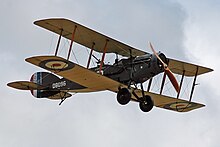Bruce Digby-Worsley
Ernest Bruce Digby-Worsley | |
|---|---|
| Born | 6 February 1899 Second Lieutenant |
| Service number | 31094 |
| Unit | Gloucestershire Regiment Middlesex Regiment King's Own Scottish Borderers Royal Flying Corps No. 88 Squadron RAF |
Background
Ernest Bruce Digby-Worsley was born on 6 February 1899 in
After the war, Digby-Worsley lived at Hargate Forest on Broadwater Down in Tunbridge Wells, Kent.[3] He pursued a successful career in theatrical management, becoming manager of the Sadler's Wells Theatre and the D'Oyly Carte Opera Company.[4]
Military career

Bruce Digby-Worsley enlisted in the
Digby-Worsley is credited with 16 aerial victories, all of them as an observer in a Bristol F.2b, and all within a mere four months of operations.[7] The observer's first four victories were from Bristol F.2b (C787) piloted by Lieutenant Kenneth Conn, a Canadian. On 5 June 1918, he scored a double victory, destroying two Albatros D.V aircraft over Messines, West Flanders, Belgium.[8] The following month, on 1 July 1918, Digby-Worsley racked up another double, taking out two Fokker D.VII planes west of Westrozebeke, West Flanders, destroying one in flames and sending the other out of control.[8]
His next seven victories, numbers 5 through 11, were all from Bristol F.2b (C4061), piloted by Lieutenant Charles Findlay, a Scottish flying ace credited with 14 aerial victories.[8] He was credited with his fifth on 30 July 1918 when he sent a Pfalz D.III out of control over Richebourg, France. His sixth kill took place on 6 August 1918, when a Fokker D.VII was destroyed in flames over Ploegsteert, Hainaut, Belgium. This was sweet revenge, for it was at Ploegsteert Wood that his first cousin, Trooper Eardley Gilbert Wallis "Bertie" Digby-Worsley of the 11th Hussars, had been killed in action on 22 October 1914. Bertie Digby Worsley was the third of 58 hussars of the 11th ("Cherry Pickers") to be killed in the First World War.[9]
The next four victories, numbers 7 through 10, all took place on 11 August 1918. In the morning, two Fokker D.VII planes were sent out of control over Clery, France. In the afternoon, two more D.VII planes were taken out over Méricourt, Pas-de-Calais, France, one destroyed in flames, and the other sent out of control. His eleventh kill took place the following day, on 12 August 1918.[8] A Fokker D.VII was destroyed east of Biaches, Somme, France.[7]
Digby-Worsley's remaining victories, numbers 12 through 16, were all from Bristol F.2b (E2216), piloted by Conn, who was the leading ace of No. 88 Squadron with 20 victories.[8] His twelfth took place on 5 September 1918, when a Fokker D.VII was sent out of control northeast of Armentières, Nord, France. On 16 September 1918, he scored a double victory, destroying two Fokker D.VII aircraft northeast of Harbourdin Airfield, near Lille, Nord, France.[8] Four days later, on 20 September 1918, Digby-Worsley racked up another double, sending one Fokker D.VII out of control over Quesnoy, France and destroying another southeast of Quesnoy. The latter was his sixteenth and final victory.[7][8]
That sixteenth victory for Digby-Worsley was the only one in which the identity of his victim is known. Leutnant Helmut Gantz of Jasta 56 died of his wounds the following day.[8] That last victory was also the only one shared with other crews. It was shared with four other aviators: Captain Edgar Johnston, Lieutenant Walter Grant, Lieutenant George Poole, and Sergeant Charles Hill. Pilot Edgar Johnston was an Australian flying ace who was the recipient of the Distinguished Flying Cross and was credited with twenty aerial victories.[10][11] His observer Walter Grant was also an Australian flying ace, and was credited with seven aerial victories.[8][12] Pilot George Poole was a British flying ace credited with five aerial victories.[8][13] His observer Charles Hill was a British flying ace credited with seven victories.[8][14]
The London Gazette reported that Digby-Worsley relinquished his commission due to illness that had been contracted while he had been on active service. Further, it was noted that he was permitted to retain his rank. This was to be effective the following day, on 26 April 1919.[15]
See also
References
- ^ Birth certificate and miscellaneous documents, Worsley family papers.
- ^ Miscellaneous records and correspondence, Worsley family papers.
- ^ "British Army WWI Medal Rolls Index Cards, 1914–1920". ancestry.com. WWI Medal Index Cards. Army Medal Office (as re-printed on Ancestry.com).
{{cite web}}: Missing or empty|url=(help) - ^ GB 1032 S/SWT/2, Sadler's Wells Theatre Archive; "D'Oyly Carte Boss A Real Who's Who," Oakland Tribune, 13 August 1955.
- ^ "Supplement to the London Gazette" (PDF). London Gazette. 25 January 1918. p. 1199. Retrieved 29 March 2012.
- ^ "The London Gazette". The London Gazette. 23 August 1918. p. 9832. Retrieved 15 April 2012.
- ^ a b c "Bruce Digby-Worsley". theaerodrome.com. The Aerodrome. Retrieved 30 March 2012.
- ^ ISBN 978-1846032011.
- ^ Miscellaneous records, Worsley family papers.
- ^ Walker, J. D. "Johnston, Edgar Charles (1896–1988)". Australian Dictionary of Biography. National Centre of Biography, Australian National University. Retrieved 30 March 2012.
- ^ "Edgar Johnston". theaerodrome.com. The Aerodrome. Retrieved 30 March 2012.
- ^ "Walter Grant". theaerodrome.com. The Aerodrome. Retrieved 30 March 2012.
- ^ "George Poole". theaerodrome.com. The Aerodrome. Retrieved 30 March 2012.
- ^ "Charles Hill". theaerodrome.com. The Aerodrome. Retrieved 30 March 2012.
- ^ "The London Gazette". The London Gazette. 25 April 1919. Retrieved 15 April 2012.
